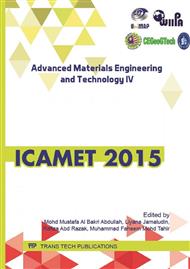p.13
p.18
p.22
p.26
p.31
p.36
p.40
p.44
p.49
Nanoindentation Study on Heat Treated Gold Wire Bonding
Abstract:
The effect of high temperature storage of gold ball bonds towards micromechanical properties has been investigated. Gold wire from thermosonic wire bonding exposed to high temperature storage at 150 °C for 10, 100 and 1000 hours. The nanoindentation test was used in order to evaluate the high temperature storage effect on wire bonding in more details and localized. Prior to nanoindentation test, the specimens were cross-sectioned diagonally. The constant load nanoindentation was performed at the center of gold ball bond to investigate the hardness and reduced modulus. The load-depth curve of nanoindentation for the high temperature storage gold wire has apparent the discontinuity during loading compared to as-received gold wire. The hardness value increased after subjected to high temperature storage. However, the hardness decreased when the storage period is extended. The decreasing in the hardness value may due to the grain size of Au metal which recrystallized after subjected to high temperature storage. The results obtained from nanoindentation is important in assessing the high temperature storage of wire bonding.
Info:
Periodical:
Pages:
31-35
Citation:
Online since:
May 2016
Price:
Сopyright:
© 2016 Trans Tech Publications Ltd. All Rights Reserved
Share:
Citation:


